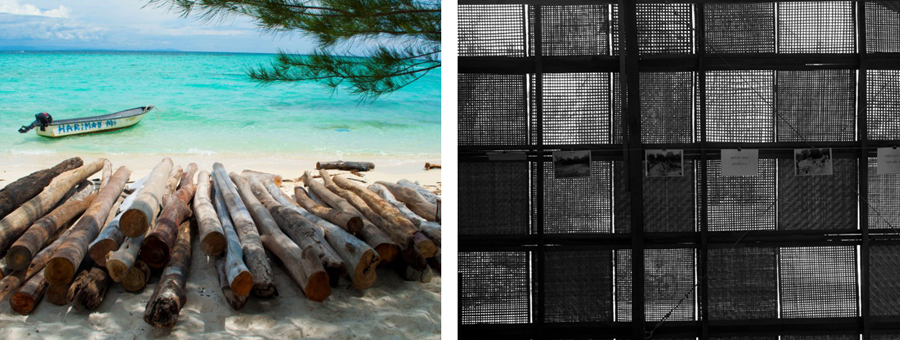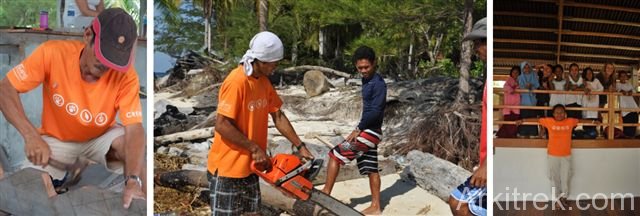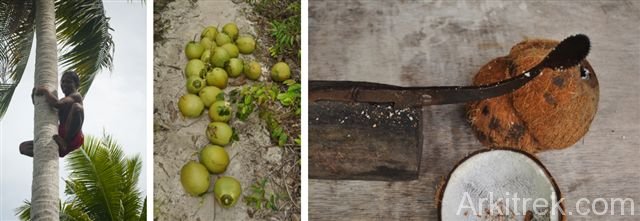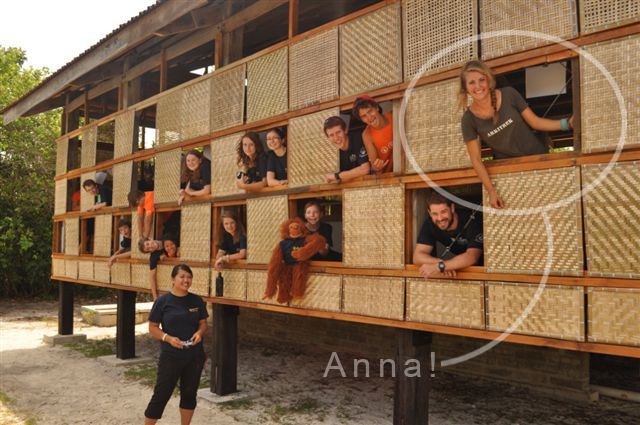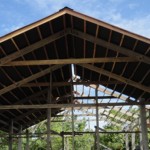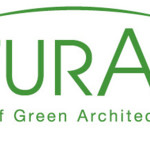Why Design/Build?
by Anna Nicholls
Trying raw sea urchin on the beach; finding design solutions with skilled craftsmen; going snorkeling to check out a local friends’ ‘pet giant clams’ and the exciting moment of installing the first bamboo woven panels on the Mantanani Community Learning Centre. The past few months interning for Arkitrek have been exciting and varied!
Staying on (and on!) after participating as part of the Arkitrek Camp2 team, I helped with the development of additional Bunkhouses and the continuation of the Community Learning Centre with the many Camps International volunteers on Mantanani Island as well as, visiting other Arkitrek project sites. What has really struck me during this time are the enormous benefits of getting stuck in to hands-on design and build projects and actually ‘making’ architecture.
REALITY
Working in real places, with real clients, on real projects, using real materials and having real budgets lessened the disparity between studying architecture and working in practice. Saying this, living in a place of such natural beauty and throwing myself into a completely different way of life did feel a bit surreal at times!
COLLABORATION
During the internship, I have tried to play the part of Architect, Quantity Surveyor, Project Manager and Builder. However, the construction work on Mantanani projects is really sustained by local craftsmen; Albi, Hashim and Normin. It was a privilege to work alongside them. Being able to incorporate their insights into our proposals really bridged the gap between innovative design and the vernacular.
Working in this participatory situation, also highlighted to me the importance of designing with the user in mind. I previously worked in an office on projects for commercial property developers designing housing as a commodity, but never actually having any contact with the real client, the inhabitants. It was refreshing to work directly with the client and users of the buildings – Camps International and the community of Mantanani.
ENVIRONMENTAL/ SOCIAL RESPONSE
Before coming to Sabah, most socio-environmental issues were just something I’d read about in articles. On Mantanani, waste dumping and fish bombing are some of the unsustainable practices carried out due to poor understanding of the impacts and the marginalized financial status of the local people. These saddening practices soon became very real. Hearing fish bombing underwater when scuba diving near the island really ‘blasts’ the reality of it into you! In regards to preserving resources, much of the Mantanani community do not think past the present. This is difficult with resources such as water, which seems so plentiful now but with no quantitative data it is hard to tell if the island could one day dry up as the population continues to grow, tourism grows and availability of modern day technologies such as washing machines increases.
Hopefully, buildings such as the Community Learning Centre and the Camp2 rainwater harvesting roof could help raise awareness of more sustainable practices, so that the local community can help decide what should be done.
BEING RESOURCEFUL MANTANANI STYLE!
Transporting materials (and waste) on and off the remote island was often tricky. It is therefore necessary to be resourceful with what there is. We would sometimes pick up disused flip flops from the beach and re-wear them ourselves! I saw that coconuts had many different uses. After project work, we went to the coconut groves to drink ‘air kelapa’ (coconut water). One of my favourite foods is kaya (coconut jam). I spent a very memorable afternoon hanging out on the porch of Normin’s house in the village with the whole family, including babies in sarong cradles, learning how to make ‘minyak kelapa’ (coconut oil). We were taught how to weave coconut leaves into panels to clad the Camp2 bunkhouse and at Hari Riya we wove small baskets out of young coconut leaves to cook rice in.
Regarding project work, understanding the value of materials was essential. We had to be creative by building with what could be thought of as ‘waste’ materials, from reclaiming timber that was left over from orders in previous years to using tin cans. This resourcefulness is something I want try to continue with now that I am home.
TESTING!
The projects provided a unique testing ground for trying out ideas on a small scale, for example building with alternative sustainable materials, such as driftwood.
RELATING TO SCALE
Working on design and build projects really heightened my sense of spatial awareness in a way that would not be possible by just working on drawings in a studio or office, where sensitivity to location, material texture and space can be lost. I was surprised by how seemingly small differences in measurements could make a large difference to how it felt to inhabit a space.
DECISIONS, DECISIONS
Although the level of autonomy over the projects could sometimes be daunting, it meant I developed the confidence to make design decisions and to be more firm about how I wanted things done (thanks to some help from Camp Manager, Aida!). Working in a situation without any building regulations meant my own decisions had to be made about what was safe or not. However, I have a tendency to waste time worrying because I don’t want to make mistakes. I found that after talking through a worry I had on the building site with local workers, the result of the conversation would be ‘tiada masalah!’ (no problem!).
Above all, it’s been a lot of fun! I arrived in Borneo with little experience in construction work. There have been a few occasions when Albi, the village chief on Mantanani, has amusedly shaken his head, taken a hammer out of my hands and proceeded to do the job himself! Therefore, aside from everything else, I have certainly learnt some practical skills. I am now even feeling inspired to take up more building crafts, especially carpentry/ joinery, both because I loved doing it and have realised how useful it is to know about how design relates to the craftsmanship of architectural details. It’s hard to be creative unless you know how things work to start with!
The challenges of these projects have made the experience even more worthwhile for me. I have thoroughly enjoyed my time in Sabah. Thank you so much to everyone at Camps International, on Mantanani and especially at Arkitrek for this brilliant opportunity and for being so welcoming!

